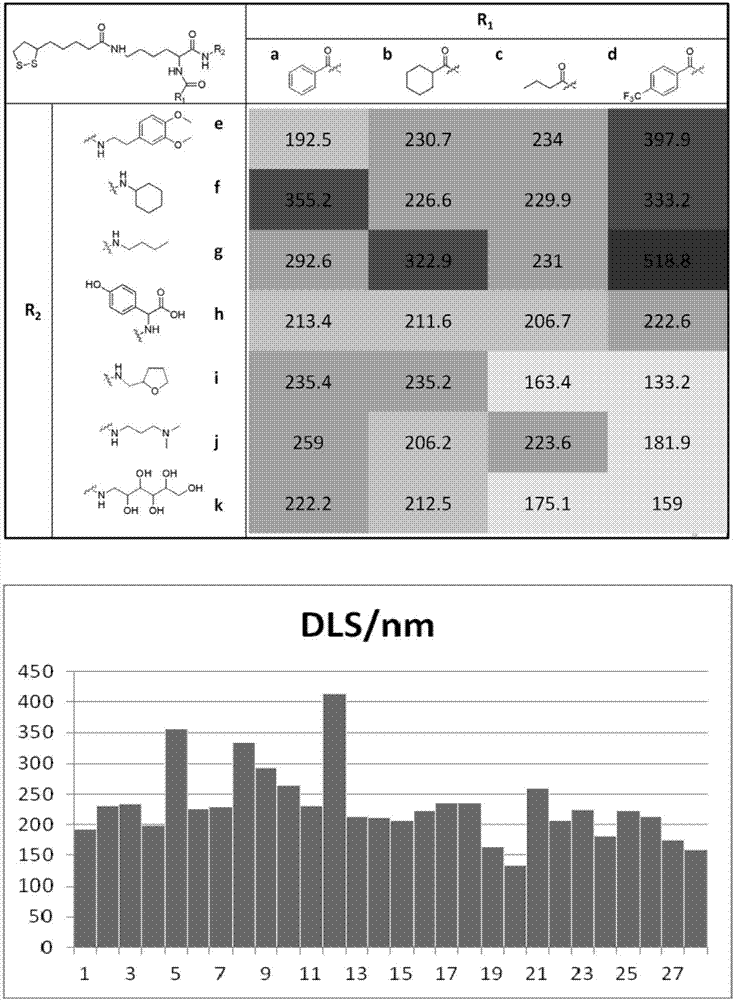Gold nanoparticle serial compound with surface diversity
A technology of gold nanoparticles and compounds, applied in gold organic compounds, 1/11 group organic compounds without C-metal bonds, organic chemistry, etc.
- Summary
- Abstract
- Description
- Claims
- Application Information
AI Technical Summary
Problems solved by technology
Method used
Image
Examples
Embodiment 1
[0098] Synthesis of gold nanoparticle series compounds:
[0099]Take the process in which the core of the lysinamide compound is connected with benzoic acid and cyclohexylamine, and then combined with gold nanoparticles to generate GNP5 as an example:
[0100] Under ice bath, 100mLH 2 O and 8.0g (200mmol) NaOH are formulated into aqueous sodium hydroxide solution. Weigh 9.85g (40mmol) N-Boc-L-lysine and dissolve it in 100mL sodium hydroxide aqueous solution. Under vigorous stirring, 4.7 mL (40 mmol) of benzoyl chloride was slowly added dropwise into the above aqueous sodium hydroxide solution. The reaction was carried out for 4-6 hours, and the reaction was monitored by TLC. After the reaction, a large amount of white solid precipitated out. After suction filtration, wash with 10% hydrochloric acid solution, saturated sodium chloride solution and water successively, and dry in the air. (1) A benzoic acid substituted intermediate was obtained.
[0101] Dissolve 3.5 g (10 ...
Embodiment 2
[0110] Morphology analysis of gold nanoparticle series compounds by transmission electron microscope:
[0111] Place the GNP1-GNP28 gold nanomaterial solution in an ultrasonic breaker and sonicate for 5 minutes, take out 50 μL of the solution and add it to a clean small tube, dilute to 1 mL with high-purity water, and sonicate again for 5 minutes to disperse the material evenly. Use a 10 μL pipette gun to carefully drop 8 μL of the material onto the copper grid, and dry it under an infrared lamp for at least 30 minutes. JEM 1011 low-resolution transmission electron microscope was used to observe the morphology of gold nanoparticles with AMT 2k CCD lens under the voltage condition of 80KV.
[0112] It is observed that the gold nanoparticles are approximately circular, with an average particle size of about 4.8nm, such as figure 1 , figure 2 shown.
Embodiment 3
[0114] Hydrated particle size analysis of gold nanoparticle series compounds:
[0115] Dilute the GNP1-GNP28 gold nanomaterial solution with high-purity water to a gold nanometer solution with a concentration of 50 μg / mL, place it in an ultrasonic breaker for 5 minutes, and use a pipette gun to take about 1 mL of the sample solution to be tested and inject it into the Sizer sample of the Malvern NanoZetasizer instrument In the pool, the particle size distribution of the gold nanoparticles to be tested in high-purity water was measured by the dynamic light scattering (Dynamic Light Scattering, DLS) method, the measurement condition was 25 ° C, and the average value was taken in parallel three times.
[0116] The dynamic hydration particle size of the obtained gold nanoparticles ranges from about 200 to 300 nm, such as image 3 shown.
PUM
 Login to View More
Login to View More Abstract
Description
Claims
Application Information
 Login to View More
Login to View More - R&D
- Intellectual Property
- Life Sciences
- Materials
- Tech Scout
- Unparalleled Data Quality
- Higher Quality Content
- 60% Fewer Hallucinations
Browse by: Latest US Patents, China's latest patents, Technical Efficacy Thesaurus, Application Domain, Technology Topic, Popular Technical Reports.
© 2025 PatSnap. All rights reserved.Legal|Privacy policy|Modern Slavery Act Transparency Statement|Sitemap|About US| Contact US: help@patsnap.com



